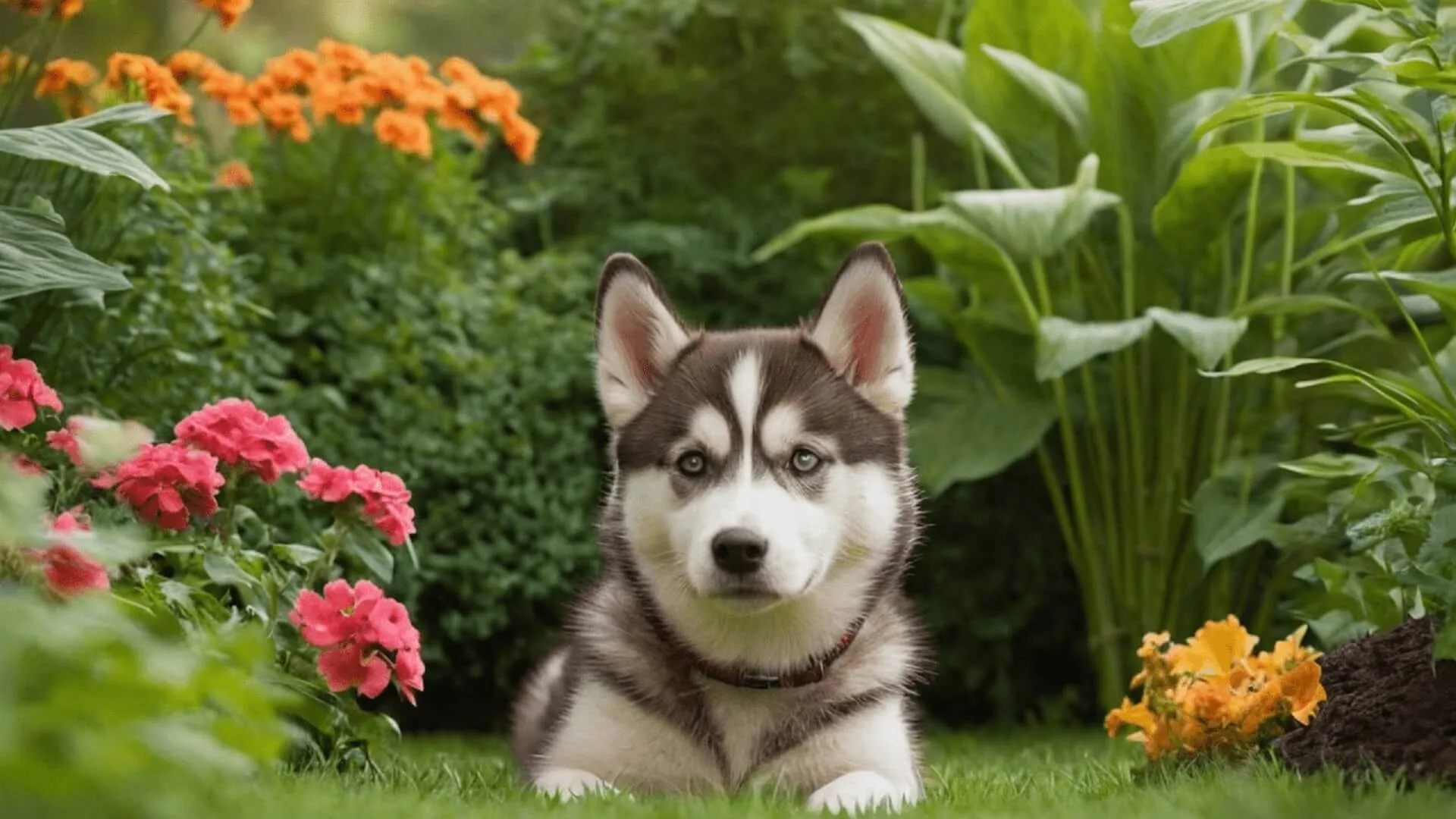Introduction
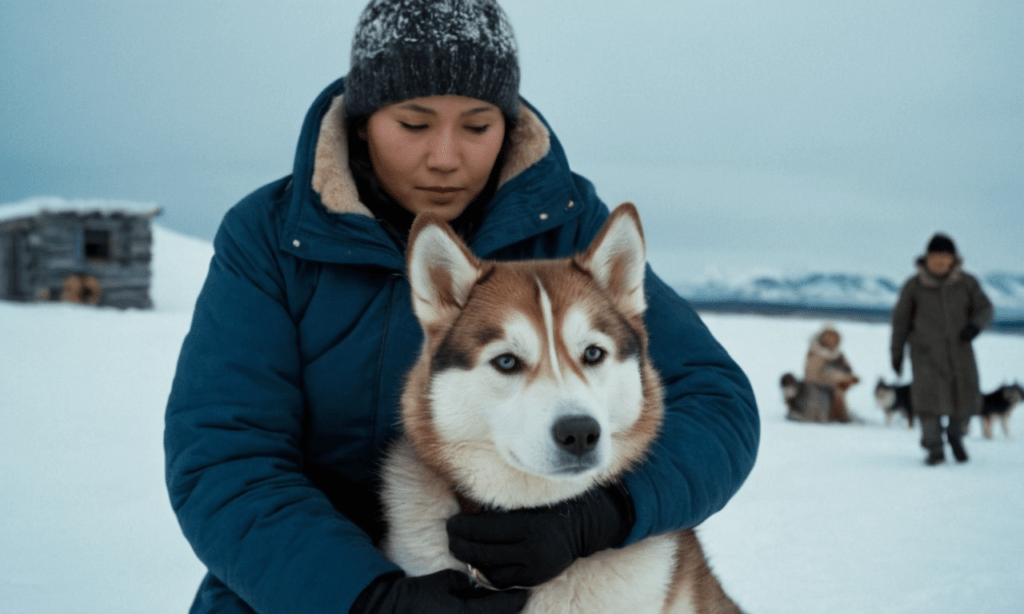
There’s this dog breed called the Miniature Siberian Husky, and it’s basically a smaller version of what you might think of as a typical sled dog. These little guys are part of the Spitz family, which means they have this super fluffy coat, pointy ears that stand up, and some pretty unique markings that make them stand out. Unlike their bigger cousin, the Alaskan Malamute, they’re more medium-sized.
Overview of the Breed
The story goes back to Northeast Asia, where the Chukchi people from Siberia first bred them. They needed dogs that could pull sleds and also be good companions in the really, really cold Siberian Arctic. Imagine how tough and energetic these dogs had to be to survive there! Then, this Russian fur trader named William Goosak brought them over to Nome, Alaska, during the gold rush. They were a hit for getting around in the snowy lands, especially for those looking for gold and needing to travel through tough spots that were otherwise hard to get through. Nowadays, even though a lot of folks keep them as pets, they’re still awesome sled dogs for both competitions and fun.
A Tapestry of Genetics: Mini Huskies and Their Ancestral Legacy
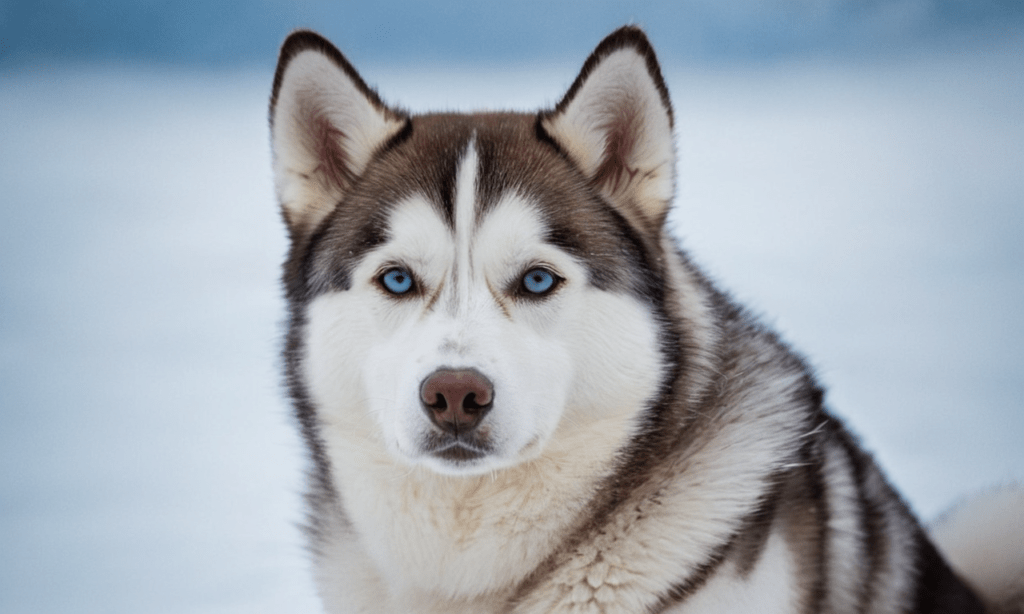
A cool fact from a DNA study in 2015 is that the Miniature Siberian Husky is closely related to the Alaskan Malamute and the Alaskan Husky. They all share a connection with sled dogs from Siberia, but they’re different from Inuit dogs like the Canadian Eskimo Dog and the Greenland Dog. In North America, both the Miniature Siberian Husky and the Malamute have kept their Siberian roots, and they’ve played a big part in creating the Alaskan Husky by mixing with European breeds. It turns out, these Mini Huskies are linked back to ancient dogs from East Siberia and Lake Baikal, with a lineage going back over 9,500 years! Isn’t that something?
So, there’s this cool fact about some Arctic dog breeds, like the Miniature Siberian Husky. They’re kind of like distant cousins to this extinct wolf from North Asia called the Taimyr wolf, thanks to some mixing that happened a long time ago. These dogs are from places way up north – we’re talking about the Miniature Siberian Husky and the Greenland Dog, which are really close to the people living in the Arctic. There’s a bit of this mixing with the Shar-Pei and Finnish Spitz too, but it’s not as much. Scientists have found that these dogs got a little bit, like 1 to 3%, of their genes from the Taimyr wolves. This mix might have helped the early dogs survive better in the cold and tough Arctic because they got some helpful traits from the wolves.
And there’s a bit of history too. The Miniature Siberian Huskies originally came from the Chukchi people who live in eastern Siberia. These dogs were super important for them and were eventually brought over to Nome, Alaska, in 1908. Over there, they became famous as sled dogs and started to be used in sled dog racing.
Flaunting Their Coats: A Cloak of Arctic Adaptability
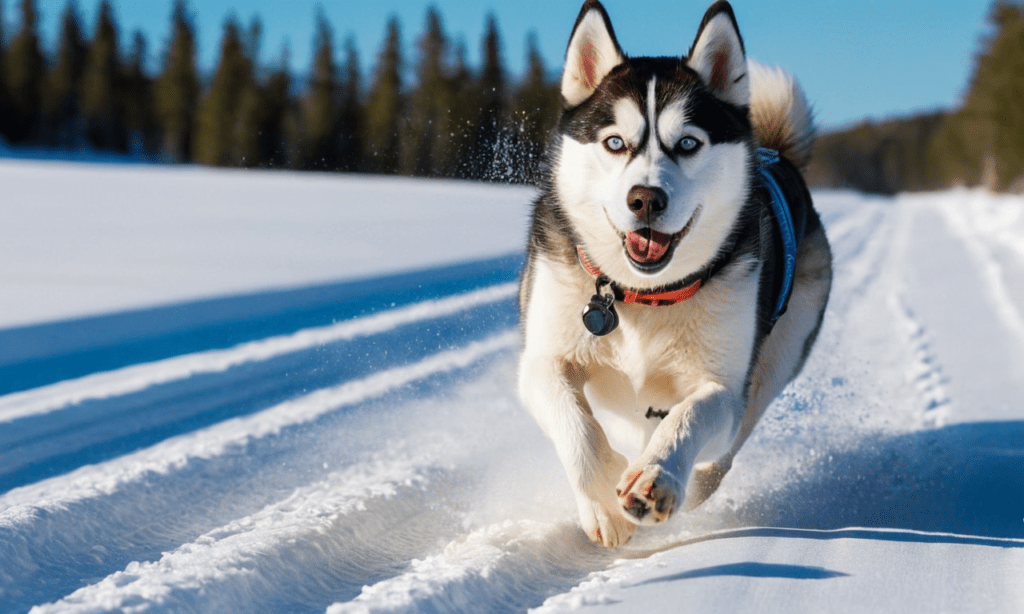
Coat
We’re talking about the Miniature Siberian Husky’s fur, right? They’ve got this super thick, two-layer coat that’s not like what most other dogs have. The bottom layer is soft and kinda curly, while the top layer has these tougher, straight hairs. This combo is perfect for keeping them cozy in super cold Arctic winters—it can handle temperatures dropping way down to between −58 to −76 °F! Imagine that! But when it gets hot, their coat also helps them stay cool. When they shed, you might not see the undercoat much.
They need a bit of brushing every week because their fur is so thick. If their hair gets too long, it’s not really good for them. It’s called a “wooly” coat and it doesn’t protect them as well, can make them overheat if they’re working hard, and gets tangled with snow and ice easily.
These little guys can be all sorts of colors, like black and white, red and white, grey and white, and even completely white. There’s this really unique color called “agouti” that’s pretty rare, and some have spots or a “saddle back” pattern where the dark hairs are mostly on their back. They often have cool face markings too, like masks or spectacles. But one thing to note is that a pattern called “merle” isn’t allowed by the big dog clubs because it can be linked to health problems and isn’t purebred.
Eyes, Nose, and Tail: The Details That Define Them
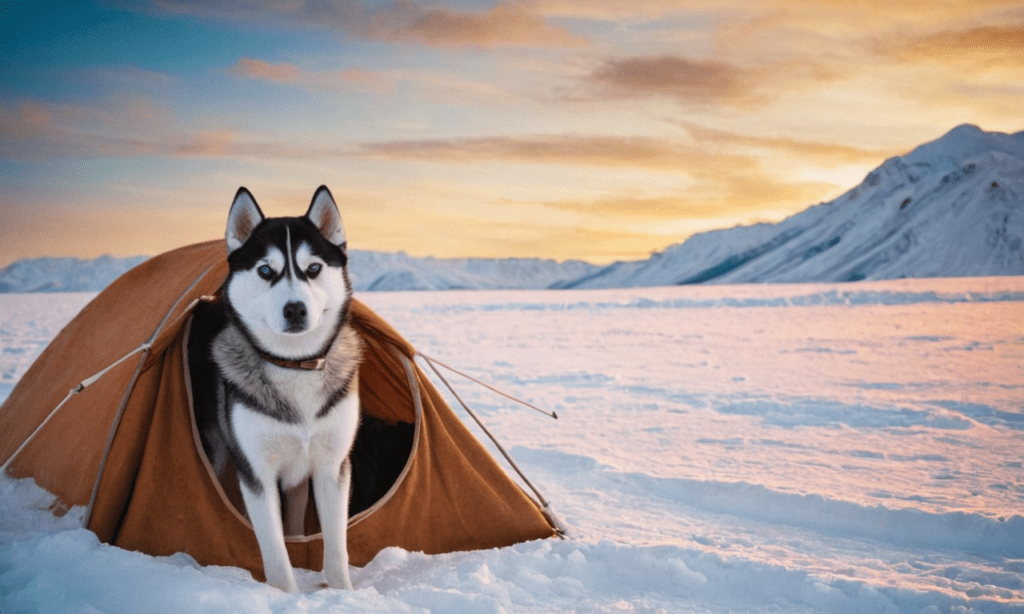
Eyes
The American Kennel Club says that Miniature Siberian Huskies and German Shepherd have eyes shaped like almonds, not too close but not too far apart, and they’re slightly slanted. When it comes to the color of their eyes, they can be brown, blue, or black. It’s also totally fine if they have one eye of one color and the other eye a different color, or even if their eyes have a mix of colors, which is a cool thing called heterochromia. According to the club, these eye color combinations are all good. And don’t worry, having different colored eyes doesn’t change how well the dog can see.
Nose
When it comes to show dogs, you don’t want their noses to be too pointy or too square. Depending on their fur color, their nose color changes too – gray dogs have black noses, black dogs have tan noses, copper-colored ones have liver noses, and white dogs can have light tan noses. Sometimes, Miniature Siberian Huskies get this thing called “snow nose” or “winter nose,” where their nose color fades a bit. It’s actually a common thing called hypopigmentation in animals, but it’s totally okay for dog shows.
Tail
Miniature Siberian Huskies have really fluffy tails. They like to curl up and use their tails to cover their faces and noses to keep warm. When they’re sleeping, they often wrap themselves in a cozy position that people call the “Siberian Swirl.” It’s like they’re making sure their nose stays warm too. According to the AKC, these dogs show their feelings through their tails. When they’re just chilling, their tails hang low. But when something catches their interest or they get excited, their tails perk up and curve like a sickle.
Size
So here’s the scoop on this dog breed. The male dogs? They’re usually about as tall as your kitchen counter – that’s between 20 and 24 inches at the shoulder. And they weigh enough to make you notice when they jump on you, but not too much, around 45 to 60 pounds. Now, the females, they’re slightly shorter, think of them barely missing the counter by an inch or so, with heights of 19 to 23 inches and they’re lighter too, weighing in between 35 and 50 pounds.
Oh, and there’s this quirky bit! Over in Nome, they had this nickname for the Miniature Siberian Huskies, calling them ‘Siberian Rats.’ Sounds hilarious, right? But it’s because they were on the smaller side, weighing about 40 to 50 pounds, which is nothing compared to the Alaskan Malamutes. Those big guys weigh like a heavy suitcase, around 75 to 85 pounds. Imagine the difference!
From Size to Behavior: Understanding These Canine Companions
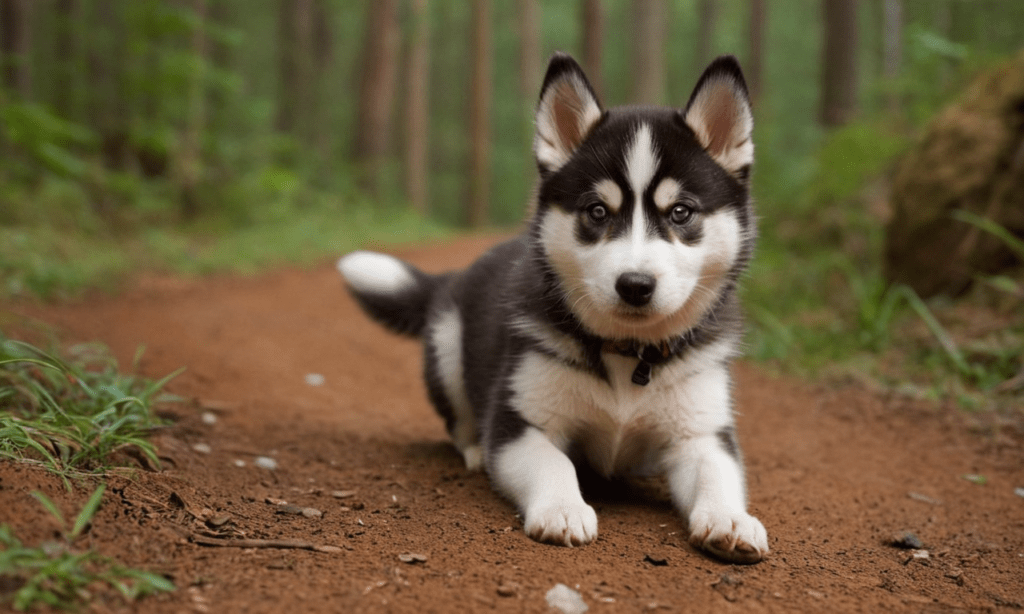
Huskies aren’t much into barking; they’re more about howling. They’re kind of like Houdinis too – give them a bit of a challenge, and they’ll figure out a way to break free, whether that’s digging under a fence, chewing through it, or just straight-up jumping over it.
Now, about Mini Siberian Huskies, they’re pretty chill with kids. This goes way back to when they were hanging out with the Chukchi families. They weren’t left to wander; they were part of the family. That’s probably why the ASPCA says they’re good with kids. But heads up, they’re like little energy bombs indoors and need their playtime. If they don’t get it, they might start thinking your shoes are chew toys.
These little guys have hunting in their DNA, thanks to their ancestors who were allowed to run wild in the summers. They used to team up and hunt for wild cats, birds, and squirrels. But don’t worry, with a bit of training, they can learn to play nice with other pets. It’s pretty cool, actually. They only used to come back home when it got cold and food was scarce. So, that hunting spirit? Yeah, it’s still very much a part of them.
So, here’s the scoop on Miniature Siberian Huskies if you’re thinking about getting one. First off, you’re gonna need a pretty tall fence, like around 6 feet tall, because these little escape artists are known to jump fences even taller than that – yep, even 8-footers! And those invisible electric fences? Might not cut it with these pups.
They’re super social creatures, loving nothing more than hanging out with humans and other dogs. They’ve got this deep need to feel like they’re part of the gang, you know?
Now, talking about their personality, they’re the sweetest. But, trying to get them to act tough or aggressive is a big no-no. It just messes with their heads and could backfire big time. They’re smart, for sure, but they’ve got this stubborn streak because they love their independence, can be a bit impulsive, and sometimes, they’re not the best at paying attention. Getting them into training early on is pretty much key to getting them to listen.
Oh, and there’s this thing where they were ranked 77th out of 138 for intelligence by this canine psychologist named Stanley Coren. But here’s the catch – that ranking was all about one specific type of smarts, like how well they follow orders. It didn’t really consider how these dogs, when they’re out there pulling sleds, have to be quick thinkers and make decisions on the fly without much guidance, which honestly, is pretty impressive and shows they’re smarter than they’re given credit for.
Intelligence and Health: A Glimpse into Their Well-being
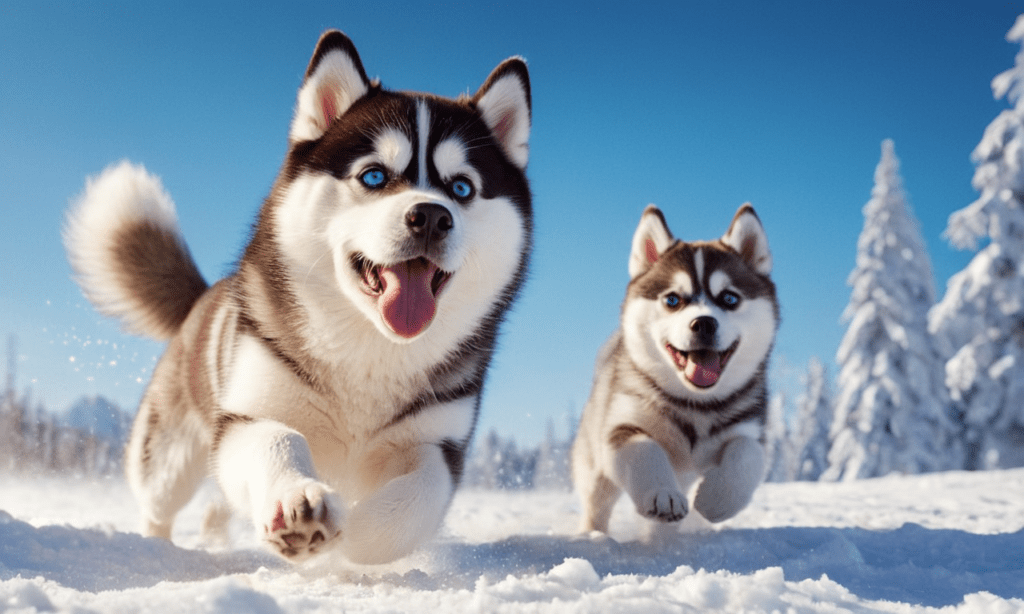
There’s this guide from the ASPCA back in 1999 that talks about Miniature Siberian Huskies. These little guys typically live between 12 to 14 years, which isn’t too shabby. Most of the health issues they might run into are passed down through their genes. This includes stuff like seizures and eye problems — think juvenile cataracts, something called corneal dystrophy, canine glaucoma, and progressive retinal atrophy. Oh, and they can also get this thing called congenital laryngeal paralysis. Hip dysplasia, which is a common problem in many bigger dogs, isn’t usually a big deal for them. But it can happen. When it comes to hip problems, the Miniature Siberian Husky is actually doing pretty good on the list, being way down at 155th out of 160 breeds, with only 2% showing any signs of hip dysplasia.
And if they’re racing dogs, pulling sleds and all that, they might get other health issues like stomach problems, bronchitis (which they interestingly call ‘ski asthma’), and even stomach ulcers or erosion. It’s a lot, but these pups are pretty sturdy overall.
Today’s Miniature Siberian Huskies in the U.S. pretty much all come from dogs that were brought over from Siberia in 1930 and from the dogs owned by Leonhard Seppala, especially one named Togo. Since there were only a few dogs that started this whole line, people often talk about how this might make them more prone to certain health issues because they all come from the same few ancestors.
Tracing Their Footsteps: A Historical Journey
Prehistoric (prior to 1890s)
The Chukotka Sled Dog is seen as the ancestor of the Miniature Siberian Husky. Created by the Chukchi people in Russia, these dogs have been part of sled teams since ancient times, helping with tasks like hunting sea animals on the icy ocean surfaces.
Beyond Sledding: Mini Huskies in Modern Activities
Between the late 1800s and early 1900s, people brought sled dogs from Chukotka (a region in Siberia) to Alaska. This was mainly to help gold miners travel to the Yukon area during the Klondike Gold Rush and for a big dog sled race called the “All-Alaska Sweepstakes,” which was a long journey of 408 miles from Nome to Candle and back. Back then, the term “Eskimo” was unfairly used to refer to the native people of the Arctic, and it had many different versions like Uskee and Huskemaw. So, the dogs that these people used were often called Huskies, which was a short form of this term. Since Chukotka is in Siberia but the folks in Canada and the U.S. didn’t really know much about Russian places, they ended up calling these dogs Miniature Siberian Huskies.
The dogs they started using were smaller, quicker, and could keep going for longer than the big dogs that were usually used for carrying heavy loads. These new dogs quickly became the stars of the sled racing world. There was this top dog breeder named Leonhard Seppala who was really into these Siberian sled dogs. From 1909 to the mid-1920s, he was all over the sled dog racing scene, winning a bunch of races with his dogs.
On February 3, 1925, Gunnar Kaasen played a key role in a critical mission, delivering a life-saving diphtheria serum over a treacherous 600-mile journey to Nome, Alaska. This heroic effort was a team achievement, involving several sled dog teams and mushers. Leonhard Seppala and his lead dog, Togo, tackled the longest and most perilous stretch, covering 264 miles. Their story inspired the 2019 movie “Togo.” Meanwhile, the 1995 animated movie “Balto” focuses on Gunnar Kaasen’s lead sled dog, Balto. Although Balto is depicted as a wolf-dog in the film, this portrayal differs from his real-life counterpart. In recognition of Balto’s bravery, a bronze statue stands in Central Park, New York City, with a plaque commemorating this incredible journey.
This tribute honors the unwavering courage of the sled dogs who bravely carried antitoxin over 600 miles of harsh ice, navigated dangerous waters, and pushed through Arctic blizzards from Nenana to bring relief to the afflicted community of Nome in the winter of 1925. It celebrates their resilience, loyalty, and smarts.
Miniature Siberian Huskies became super popular because of a big event called the “Great Race of Mercy” in 1925. This was when a bunch of dogs helped deliver medicine to Nome, Alaska. Among these dogs, Balto got famous because he ran the last part of the journey, about 53 miles, and delivered the medicine. But actually, it was Togo who did the most work. He ran the longest distance, about 261 miles, with his owner Leonhard Seppala. They even crossed a really dangerous area called the Norton Sound to get to a place called Golovin. Togo was so important that he helped start the Miniature Siberian Husky breed. His kids, like Toto, Molinka, Kingeak, Ammoro, Sepp III, and Togo II, continued his legacy.
Back in 1930, they stopped sending these dogs from Siberia to other places. That same year, a group called the American Kennel Club decided that the Miniature Siberian Husky was an official breed. Then, about nine years later, Canada also started recognizing these dogs officially. The United Kennel Club, another big dog organization, first called them “Arctic Husky” in 1938 but changed it to Miniature Siberian Husky in 1991. There was this guy named Seppala who had a dog team in Alaska, but then he moved to New England and teamed up with Elizabeth Ricker. Together, they had this kennel in Poland Springs where they would race and show their dogs all around the Northeast. In 1931, after Seppala went back to Alaska, they sold the kennel to a guy from Canada named Harry Wheeler.
The breed’s foundation stock per records and studbooks consists of:
- Kree Vanka was a male dog that came from Siberia in 1930.
- Tserko, another male dog, also arrived from Siberia that same year.
- Tosca, a female, is the offspring of Harry and Kolyma.
- Duke, known to some as Chapman’s Duke, is a male whose parents are thought to be Ici and Wanda.
- Tanta of Alyeska is a female dog, daughter of Tuck and Toto.
- Sigrid III of Foxstand, a female, was born to Chenuk and Molinka.
- Smokey of Seppala is a male, with Kingeak and Pearl as his parents.
- Sepp III, a male, comes from the famous Togo and Dolly.
- Smoky is a male dog with unknown parents.
- Dushka, a female, is the puppy of Bonzo and Nanuk.
- Kabloona, a female, was born to Ivan and Duchess.
- Rollinsford Nina of Marilyn, a female, comes from Kotlik and Nera of Marilyn.
So, back in 1933, there was this Navy guy, Rear Admiral Richard E. Byrd, who decided to take around 50 Miniature Siberian Huskies on a huge adventure. He wanted to go all around Antarctica’s coast, which is like 16,000 miles long. A lot of these small huskies came from a place in New Hampshire called Chinook Kennels, run by someone named Eva Seeley. This whole big trip was named Operation Highjump, and it really showed how awesome these little huskies were because of their small size and super-fast speed. They even helped out the US Army during World War II in a special group that looked for lost people in the Arctic. And guess what? People loved these dogs so much that they became super popular. By 2012, they were like the 16th most registered breed with the American Kennel Club, and they even climbed up to the 14th spot the next year.
1940s-present
From 1945 to 1994, huskies played a big role in helping British scientists move around the icy lands of Antarctica. They pulled sleds, making exploration possible. To honor these incredible dogs, there’s a bronze statue right outside the main office of the British Antarctic Survey in Cambridge. It’s not just any statue; it carries the names of all those loyal huskies on a plaque, remembering each one of them.
In 1960, the US Army started a special project to build a secret research base under the ice, called Camp Century. This was part of Project Iceworm. More than 150 people worked there, and they even had a small Siberian Husky named Mukluk as their unofficial mascot. They brought Mukluk along for company and morale.
Miniature Siberians are super popular, but they need a lot of care, both physically and mentally. Sadly, a lot of people get them without realizing how much work they are, and end up giving them up to shelters. Many people fall for their cute looks and what they’ve seen in movies or on TV, and end up buying puppies from places that aren’t looking out for the dogs’ best interests. Unlike good breeders who make sure the dogs don’t end up in shelters by taking them back if needed, these places don’t offer that kind of safety net.
Sled dogs that the Chukchi tribes in Siberia had were once believed to be gone for good. However, Benedict Allen shared some good news in Geographical magazine in 2006 after he visited the area. He found out that these dogs are still around. He talked about how the Chukchi people pick dogs that listen well, can run for a long time, are friendly, and aren’t too big or costly for a family to take care of.
Traditional use and other activities
So, huskies, right? They were originally the go-to dogs for pulling sleds in cold, snowy places. What makes them stand out from other dogs is how quickly they can pull those sleds. Nowadays, the huskies you see in sled races are a mix of the quickest dogs out there, and we call them Alaskan huskies. People use them in sled-dog racing competitions. Also, there are these companies that set up sled tours for folks looking for a bit of adventure in snowy areas. Apart from all that excitement, many people just love having huskies as pets. And when these dogs retire from racing or those adventurous treks, there are groups dedicated to finding them new homes where they can just chill and be loved.
Huskies, especially the smaller ones like Miniature Siberian Huskies, are super active and love to work. They really need their daily exercise to stay happy and healthy, both in body and mind. When they get enough playtime, it helps them bond with their owners too. Nowadays, lots of people have huskies as pets in places where you can’t really do traditional sledding. So, folks have come up with other fun activities to keep their furry friends entertained and engaged.
In Rally Obedience, you and your dog team up to follow a set path that has about 10 to 20 markers. At each marker, you’ll get your dog to do a specific trick or command. It’s like a fun teamwork challenge!
Agility Training is all about speed and focus. Your dog will run through an obstacle course, trying to beat the clock while making sure to get each obstacle right. It’s like a fast-paced game where concentration is key.
Skijoring is a cool twist on sled pulling. Instead of a sled, you’ll be on skis, and your dog will pull you along with a rope that connects you two. It’s a fun way to enjoy the snow together!
Going for a hike with your dog is a great option for pet owners who can get to a trail or live close by. When you hike together through nature, both you and your dog get a good workout without relying on the dog’s natural instinct to pull. Plus, there are special companies that create gear just for dogs, so they can carry their own stuff like water, food, and bowls.
Carting, or what some folks call dryland mushing or sulky driving, is like the city cousin of dog sledding. Instead of snow and sleds, a dog pulls a cart around, which can carry stuff or even a person. It’s a cool way to channel a dog’s love for pulling into something useful. You can get these carts ready-made or, if you’re feeling crafty, you can build one yourself.
Bikejoring is when you ride your bike and your dog comes along, hooked up to the bike with a special harness to keep both of you safe. Your dog, or even a group of dogs, can be connected with a line that lets them help pull you along.
A Cultural Pawprint: Mini Huskies in the Spotlight
Since 1925, there’s been a bronze statue of Balto in Central Park, New York City, and it’s really loved by everyone who visits.
The Twilight Saga and Game of Thrones, which have werewolves and cool direwolves, made a lot of people want Miniature Siberian Huskies as pets. This led to a lot more of these dogs ending up in shelters. Even though the animals in the shows weren’t actually Miniature Siberian Huskies, people got them because they look similar to the direwolves from Game of Thrones. Two actors from the show even asked fans to really think it over before getting these dogs, to make sure they knew what they were getting into with the breed.
The expression “three dog night” refers to a night so chilly that you’d need three dogs in bed with you just to stay warm. This term comes from the Chukchi people in Siberia. They had a type of small Siberian husky dog that later evolved into the breed we now know as the Miniature Siberian Husky.
Back in 1943, during World War II, the good guys, known as the Allies, launched a massive attack on Sicily. They called this big operation ‘Operation Husky.’
You know those small, fluffy Miniature Siberian Huskies? Well, several of them got to play the role of Diefenbaker, a ‘half-wolf’ pet of a Royal Canadian Mounted Police officer named Benton Fraser, in a TV show called Due South that aired on CBS. It was pretty cool!
Also, those adorable Miniature Siberian Huskies are like the cheerleaders for the sports teams at many schools and colleges. They’re the proud mascots for teams at places like St. Cloud State University (they’ve got Blizzard the Husky), Northern Illinois University (meet Victor), the University of Connecticut (hello, Jonathan), Northeastern University (Paws is the star there), Michigan Technological University (another Blizzard, but this one’s their own), University of Washington (Harry’s leading the cheers), Houston Baptist University (Kiza the Husky’s the cute face there), and even Saint Mary’s University and George Brown College have their own Husky mascots. It’s like these huskies are everywhere, spreading school spirit and making games more fun!
